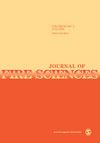球形羟基锡酸钴的制备及其在聚氯乙烯中的阻燃抑烟效果
IF 1.9
4区 工程技术
Q2 ENGINEERING, MULTIDISCIPLINARY
引用次数: 3
摘要
制备了球形羟基锡酸钴,并通过X射线衍射、扫描电子显微镜、傅立叶变换红外光谱和热重分析仪-傅立叶变换红外谱对其进行了表征。结果表明,羟基锡酸钴微球的平均粒径为440nm,分散均匀。采用极限氧指数法、万能拉伸试验机、热重分析仪-傅立叶变换红外光谱法、扫描电子显微镜、X射线衍射法和激光拉曼光谱法对羟基锡酸钴处理的阻燃柔性聚氯乙烯进行了研究。与纯聚氯乙烯相比,用10份羟基锡酸钴处理的聚氯乙烯样品(PVC/10)的极限氧指数值提高了4%点,其总放热和总产烟量分别降低了18%和50%。这一结果可归因于羟基锡酸钴脱水产生的水,以及羟基锡酸酸钴与聚氯乙烯基体的相互作用,产生了致密且高度石墨化的焦渣,其中含有六方相石墨、CoCl2、Co2O3和Co3O4。本文章由计算机程序翻译,如有差异,请以英文原文为准。
Preparation of spherical cobalt hydroxystannate and its flame retardant and smoke suppressant effect in poly(vinyl chloride)
Spherical cobalt hydroxystannate was prepared and characterized by X-ray diffraction, scanning electron microscopy, Fourier-transform infrared spectroscopy, and thermogravimetric analyzer–Fourier-transform infrared spectroscopy. Results showed that cobalt hydroxystannate spheres have an average particle size of 440 nm and disperse uniformly. The flame-retardant flexible poly(vinyl chloride) treated with cobalt hydroxystannate was studied by the limiting oxygen index, universal tensile testing machine, thermogravimetric analyzer–Fourier-transform infrared spectroscopy, scanning electron microscopy, X-ray diffraction, and laser Raman spectra methods. Compared with the pure poly(vinyl chloride), the limiting oxygen index value of the poly(vinyl chloride) sample (PVC/10) treated with 10 phr of cobalt hydroxystannate is increased by 4% points, and its total heat release and total smoke production decreased by 18% and 50%, respectively. The result could be attributed to the water produced by the dehydration of cobalt hydroxystannate, and the interaction of cobalt hydroxystannate and the poly(vinyl chloride) matrix, which produces dense and highly graphitized char residue containing hexagonal phase graphite, CoCl2, Co2O3, and Co3O4.
求助全文
通过发布文献求助,成功后即可免费获取论文全文。
去求助
来源期刊

Journal of Fire Sciences
工程技术-材料科学:综合
CiteScore
4.00
自引率
0.00%
发文量
14
审稿时长
2.5 months
期刊介绍:
The Journal of Fire Sciences is a leading journal for the reporting of significant fundamental and applied research that brings understanding of fire chemistry and fire physics to fire safety. Its content is aimed toward the prevention and mitigation of the adverse effects of fires involving combustible materials, as well as development of new tools to better address fire safety needs. The Journal of Fire Sciences covers experimental or theoretical studies of fire initiation and growth, flame retardant chemistry, fire physics relative to material behavior, fire containment, fire threat to people and the environment and fire safety engineering. This journal is a member of the Committee on Publication Ethics (COPE).
 求助内容:
求助内容: 应助结果提醒方式:
应助结果提醒方式:


